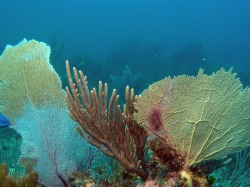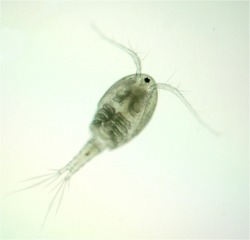Saint Barthelemy is a Caribbean island located in the French West Indies. Known for sophisticated high-end tourism, the island is also home to coral reefs, salt ponds, beaches, sand dunes, and mountains, habitats that harbor an array of creatures. The island offers an appropriate setting for the Brosnan Center. On location on St. Barths, we are engaged in several projects that convene visiting scientists from around the world, and that support scientists and graduate students in projects to restore healthy ecosystems, address human-wildlife health (dengue fever) and more. You can follow our exciting field work and activities in St. Barths directly through our field blog.
Designing our natural future: St. Jean Bay, Gouverneur

A complex ecosystem of reefs, seagrass beds, sandy beach, dunes, and a salt pond lagoon, this extraordinary bay is a centerpiece of traditional and modern living. On land, tourism has flourished. However underwater, the bay has been subject to many stressors that have impacted the ability of the reefs and other habitats to provide essential ecosystem services, from fisheries to beach stabilization. Following up on the pioneering work to advance the concept of designing the future, we are now putting it into practice. Scientists and students at the Brosnan Center are working with the government and the community to initiate a restoration effort to return the reefs to coral dominance and integrate the work with larger ecosystem planning. In Gouverneur we are busy with restoration of another complex habitat- sand dunes. This study in whole ecosystem restorations aims to recover the full architecture, zonation, and suite of plants that comprise these habitats. Visit the project
Coral Reefs

As with the rest of the Caribbean, the reefs around St. Barths have been impacted by multiple stressors over the last 20 years, including: overfishing, increased nutrient loading, disease, coral bleaching, and die-off of the grazing urchin Diadema antillarum. As a result of these multiple stressors, the reefs have entered an alternative stable state in which algae (seaweed) is the dominant life form instead of coral. Thus, the Brosnan Lab is undertaking a restoration effort to return the reefs to coral dominance. Currently, the project is focusing on St. Jean Bay, centrally located on the northern section of the island.
The restoration project is currently in a pilot phase in which several methods will be tested to determine their effectiveness in this system. We have set up test plots on Eden Rock to evaluate the effectiveness of algal clearing as a coral restoration method in St. Jean Bay. Because corals and algae compete for space, by physically clearing as much algae as possible, we are paving the way for coral recruits to settle and grow. Another method we are employing is coral transplantation. We utilize "corals of opportunity" which are coral fragments that have broken off the reef and would otherwise die. We rescue these fragments and literally adhere them back to the reef. By doing so we are providing an adult population, which may increase local larval supply. Thus, by clearing algae we are also providing areas to transplant adult corals onto. We want to make the site as habitable as possible to ensure successful transplantation.
Additionally, we are establishing six long-term monitoring sites throughout St. Jean Bay. These are representative of the overall reef habitat and structure, with three sites on the back-reef and three on the fore-reef. By collecting baseline data now, we can use it to monitor future changes to the reef.
The restoration project is currently in a pilot phase in which several methods will be tested to determine their effectiveness in this system. We have set up test plots on Eden Rock to evaluate the effectiveness of algal clearing as a coral restoration method in St. Jean Bay. Because corals and algae compete for space, by physically clearing as much algae as possible, we are paving the way for coral recruits to settle and grow. Another method we are employing is coral transplantation. We utilize "corals of opportunity" which are coral fragments that have broken off the reef and would otherwise die. We rescue these fragments and literally adhere them back to the reef. By doing so we are providing an adult population, which may increase local larval supply. Thus, by clearing algae we are also providing areas to transplant adult corals onto. We want to make the site as habitable as possible to ensure successful transplantation.
Additionally, we are establishing six long-term monitoring sites throughout St. Jean Bay. These are representative of the overall reef habitat and structure, with three sites on the back-reef and three on the fore-reef. By collecting baseline data now, we can use it to monitor future changes to the reef.
Salt Pond

Work to restore the historic St. Jean salt pond, an integral part of St. Jean Bay, is progressing with the advice and input of The Brosnan Center. A team of coastal engineers visited the island to evaluate the dynamics of the salt-pond system. Examining everything from the geology, sedimentology, hydrology, and engineering, the team is now working up their results. Their work on the bathymetry and flow dynamics within St. Jean Bay will play an important role in the Center's work, especially understanding and restoring the reef and beach habitats.
Pictured at Left: Flow studies in St. Jean Bay with nontoxic pink dye
Pictured at Left: Flow studies in St. Jean Bay with nontoxic pink dye
Human and Wildlife Health

Wildlife-born diseases are emerging as a major driver of human health and wellbeing. On St. Barths, one such disease is Dengue Fever. Dengue is caused by a virus, which is transmitted by mosquitoes, notably the Aedes aegypti mosquito, which only feeds during the day. Four serotypes (strains) of the virus exist: DEN-1, DEN-2, DEN-3, and DEN-4. If a person is infected with one serotype, they may develop Dengue fever, which is characterized by a high fever, severe headache, muscle and joint pain, rash, or bruising. If a person is later infected with a different strain of the virus, they are at higher risk for developing Dengue Hemorrhagic Fever (DHF), which can cause life-threatening symptoms such as persistent vomiting, severe abdominal pain, internal hemorrhage, and shock.
There is no specific medication to treat Dengue fever or DHF. Pain Relievers with acetaminophen may be used (NOTE: do NOT use aspirin-containing products or non-steroidal anti-inflammatories, as these can worsen bleeding); fluid replacement therapy and hospitalization is often required for DHF. Currently, there is no vaccine available for Dengue. The best preventative measure is to implement sustainable, community-based mosquito control. As this mosquito prefers to lay eggs in artificial containers that hold water, it is important to clean items that may collect rainwater (buckets, old tires, pet dishes) at least once a week to prevent the eggs and larvae from maturing. Application of mosquito repellants that contain 20-30% DEET to exposed skin and clothing reduces the risk of being bitten by mosquitoes.
Data from the Pan American Health Organization (PAHO) show that in 2009, Saint Barthelemy had the highest incidence rate for Dengue infection in the entire Caribbean. Preliminary data from 2010 report roughly the same number of cases of Dengue on St. Barths in the first six months of 2010, as for the entire year of 2009. These frightening numbers suggest not only that Dengue has a strong presence on the island, but that infections are increasing. Here at the Brosnan Center, we are studying the relationship between the biology, sociology, and economics of Dengue fever. We are examining the economic impact of Dengue to St. Barths, based on medical costs, blood testing, and the costs associated with days off of work, which may impact individuals, as well as the island's main industry - tourism.
In addition, the Center is working on a proposal to reduce mosquito populations using a local inhabitant, the copepod (pictured below). Copepods are microscopic crustaceans that live in water sources: oceans, lakes, and streams. Several species eat mosquito larvae, and can be introduced into the artificial containers where Aedes mosquitoes, which carry the Dengue virus, normally breed. Copepods have been used successfully in New Orleans, Louisiana and Vietnam, where they have eradicated the mosquitoes, and effectively, Dengue. The Brosnan Center is hopeful that a similar program could be successfully implemented in St. Barths. Until the copepod project is underway, mosquito larvae can be controlled by spraying a small amount of cooking oil over the surface of any standing water. The oil suffocates and kills the larvae. In addition, the oil is non-toxic to animals that may drink the water, and will evaporate over a few days. Oil should be applied at least weekly, to break through the life cycle of the mosquito.
There is no specific medication to treat Dengue fever or DHF. Pain Relievers with acetaminophen may be used (NOTE: do NOT use aspirin-containing products or non-steroidal anti-inflammatories, as these can worsen bleeding); fluid replacement therapy and hospitalization is often required for DHF. Currently, there is no vaccine available for Dengue. The best preventative measure is to implement sustainable, community-based mosquito control. As this mosquito prefers to lay eggs in artificial containers that hold water, it is important to clean items that may collect rainwater (buckets, old tires, pet dishes) at least once a week to prevent the eggs and larvae from maturing. Application of mosquito repellants that contain 20-30% DEET to exposed skin and clothing reduces the risk of being bitten by mosquitoes.
Data from the Pan American Health Organization (PAHO) show that in 2009, Saint Barthelemy had the highest incidence rate for Dengue infection in the entire Caribbean. Preliminary data from 2010 report roughly the same number of cases of Dengue on St. Barths in the first six months of 2010, as for the entire year of 2009. These frightening numbers suggest not only that Dengue has a strong presence on the island, but that infections are increasing. Here at the Brosnan Center, we are studying the relationship between the biology, sociology, and economics of Dengue fever. We are examining the economic impact of Dengue to St. Barths, based on medical costs, blood testing, and the costs associated with days off of work, which may impact individuals, as well as the island's main industry - tourism.
In addition, the Center is working on a proposal to reduce mosquito populations using a local inhabitant, the copepod (pictured below). Copepods are microscopic crustaceans that live in water sources: oceans, lakes, and streams. Several species eat mosquito larvae, and can be introduced into the artificial containers where Aedes mosquitoes, which carry the Dengue virus, normally breed. Copepods have been used successfully in New Orleans, Louisiana and Vietnam, where they have eradicated the mosquitoes, and effectively, Dengue. The Brosnan Center is hopeful that a similar program could be successfully implemented in St. Barths. Until the copepod project is underway, mosquito larvae can be controlled by spraying a small amount of cooking oil over the surface of any standing water. The oil suffocates and kills the larvae. In addition, the oil is non-toxic to animals that may drink the water, and will evaporate over a few days. Oil should be applied at least weekly, to break through the life cycle of the mosquito.
To learn more about our activiites in St. Barths, visit our St. Barths Blog.
© 2010 by Dr. Deborah Brosnan. All rights reserved.

